Click on images to enlarge
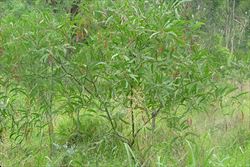
infestation in bushland (Photo: Sheldon Navie)

habit (Photo: Sheldon Navie)
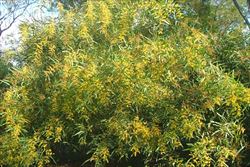
habit in flower (Photo: Sheldon Navie)
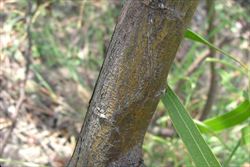
older stem (Photo: Sheldon Navie)

zig-zagging stems (Photo: Sheldon Navie)
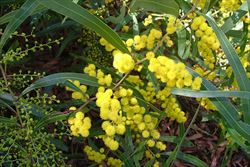
flower clusters (Photo: Sheldon Navie)
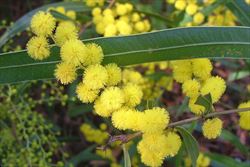
close-up of globular flower clusters (Photo: Sheldon Navie)
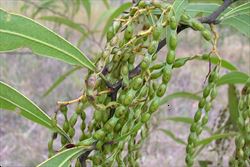
immature fruit (Photo: Sheldon Navie)
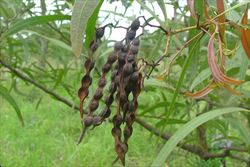
mature fruit and reddish new growth (Photo: Sheldon Navie)
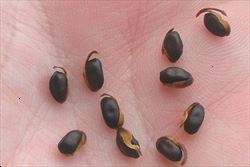
close-up of seeds (Photo: Sheldon Navie)
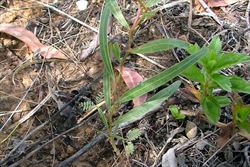
young plant with remnant twice-compound leaves (Photo: Sheldon Navie)
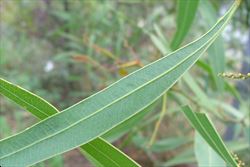
close-up of 'leaf' showing prominent midrib and raised margins (Photo: Sheldon Navie)
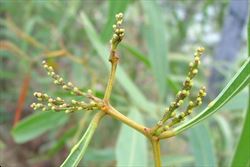
young flower clusters and glands near the 'leaf' bases (Photo: Sheldon Navie)
Scientific Name
Acacia macradenia Benth.
Synonyms
Racosperma macradenium (Benth.) Pedley
Family
Fabaceae: sub-family Mimosoideae (New South Wales)Leguminosae (South Australia)Mimosaceae (Queensland, the ACT, Victoria, Tasmania, Western Australia and the Northern Territory)
Common Names
zig-zag wattle, zigzag wattle
Origin
Native to the inland districts of southern and central Queensland. It is widespread from the Clermont area south to near Surat and Chinchilla, with a northern outlier north-east of Hughenden.
Cultivation
Zig-zag wattle (Acacia macradenia) is a very decorative species and is common in cultivation in eastern Australia, particularly in Brisbane and in other parts of south-eastern Queensland.
Naturalised Distribution
This species is naturalised beyond its native range in the coastal districts of south-eastern Queensland.
Habitat
In its natural environment, in semi-arid central Queensland, it grows in stony or sandy soils in open woodlands, often near creeks or on hillsides.
In south-eastern Queensland it has become naturalised along roadsides, in parks, in waste areas and in eucalypt woodlands.
Habit
A shrub or small tree growing 3-6 m tall with a spreading habit.
Distinguishing Features
- a large shrub or small tree with alternately arranged simple 'leaves' and zig-zagging branches.
- its long and narrow dark green 'leaves' have a single central vein running lengthwise and prominent margins.
- its new growth (i.e. young 'leaves' and branches) are often reddish in colour.
- its bright yellow or golden yellow flowers are borne in small globular clusters that are arranged in compound clusters in the leaf forks.
- its elongated and flattened pods (up to 8 cm long and 5 mm wide) are constricted between each of the seeds.
Stems and Leaves
The older stems are covered in a relatively smooth dark brown coloured bark, while younger stems are greenish or yellowish-green in colour. The younger branches are generally drooping in nature (i.e. pendulous), often with a zig-zagging appearance (i.e. they are flexuose). These branches are hairless (i.e. glabrous) and become somewhat angular towards their tips.
The 'leaves' of this plant are actually flattened and widened leaf stalks (i.e. petioles), and not leaves in the true sense of the word. These modified leaf stalks are called phyllodes, but serve the same function as a regular leaf. On very young plants, partially formed phyllodes can be seen which bear twice-compound (i.e. bipinnate) leaves at their tips. As the seedling grows, each new 'leaf' has phyllodes that are more fully formed and the leaves at their tips eventually vanish altogether. The dark green phyllodes (8-25 cm long and 8-25 mm wide) are relatively straight to noticeably curved and tapered at both ends. They are elongated in shape (i.e. lanceolate to narrowly elliptic) and generally 8-20 times longer than they are broad. They are also hairless (i.e. glabrous) and have a single prominent central vein (i.e. midrib) running lengthwise. The margins of the phyllodes are also raised and prominent. These phyllodes usually come to a long-pointed tip (i.e. acuminate apex) and where they join to the stem there is a slightly thickened flexible joint (i.e. a pulvinus). There is a small elongated raised structure (i.e. gland), up to 3.5 mm long, present on the edge of the phyllode about 1-10 mm above the pulvinus, and occasionally one or two smaller 'glands' further along the top margin of the phyllode. New growth (i.e. young phyllodes and branchlets) on this species is often reddish in colour.
Flowers and Fruit
The small bright yellow or golden-yellow flowers are stalkless (i.e. sessile) and very densely arranged into globular clusters (about 10 mm across), each containing numerous (35-50) flowers. The individual flowers have five relatively inconspicuous petals and sepals and numerous conspicuous stamens that give them a fluffy appearance. The globular flower clusters are borne on short stalks (i.e. peduncles) 3-6 mm long, and 8-25 of them are alternately arranged along a short branch (2-8 cm long) emanating from the forks (i.e. axils) of the leaves (i.e. in axillary racemes). Flowering occurs during a short period in winter and early spring (i.e. from July to September) and is usually very prolific and spectacular.
The fruit is a very elongated (i.e. linear) and somewhat flattened pod (up to 8 cm long and 5 mm wide) that is slightly to moderately constricted between each of the seeds. These pods are straight or slightly curved, hairless (i.e. glabrous), and smooth in texture. They and are initially green in colour with a leathery appearance, but turn turn dark brown as they mature. Mature fruit are generally present during late spring (i.e. in October and November). The seeds are oblong in shape (about 4 mm long and 2.5 mm wide) and have a small fleshy structure (i.e. aril) attached to one end.
Reproduction and Dispersal
Zig-zag wattle (Acacia macradenia) produces numerous hard seeds, that are probably long-lived like those of other acacias.
Its seeds are probably spread by animals (e.g. birds and ants) and they may also be dispersed in dumped garden waste and contaminated soil. However, this species is most commonly spread as a result of its use in re-vegetation and amenity plantings.
Environmental Impact
This species is now regarded as an emerging environmental weed in south-eastern Queensland. It has been widely cultivated in gardens in the coastal parts of this region because of its unusual architecture and striking floral displays. It is also commonly planted along roadsides and in amenity areas, because it is 'native' to Queensland. However, it is not native to this part of the state and has spread from such plantings, particularly in the Greater Brisbane and Gold Coast areas.
For example, zig-zag wattle (Acacia macradenia) was planted extensively along the margins of the Toohey Forest at Nathan in the south-east of Brisbane some time ago. It has now spread into extensively into Toohey Forest, where it hybridises with the local Brisbane wattle (Acacia fimbriata). Therefore, this species should be taken seriously as a weed because it has the ability to invade natural bushland areas and replace populations of native wattles with unnatural hybrids. It has also recently been observed in parks and reserves in many parts of western Brisbane (e.g. Mount Crosby, St. Lucia, Redbank and Mount Coot-tha).
Legislation
This species is not declared or considered noxious by any state or territory government in Australia.
Similar Species
This species is rather distinctive with its zig-zagging stems, and is rarely confused with other wattles (i.e. Acacia spp.) that are present in Queensland.
However, for an in-depth key to distinguish between the wattles (Acacia spp.) present in Australia, see the Wattle: Acacias of Australia CD-ROM or Flora of Australia, Volumes 11A and 11B.

